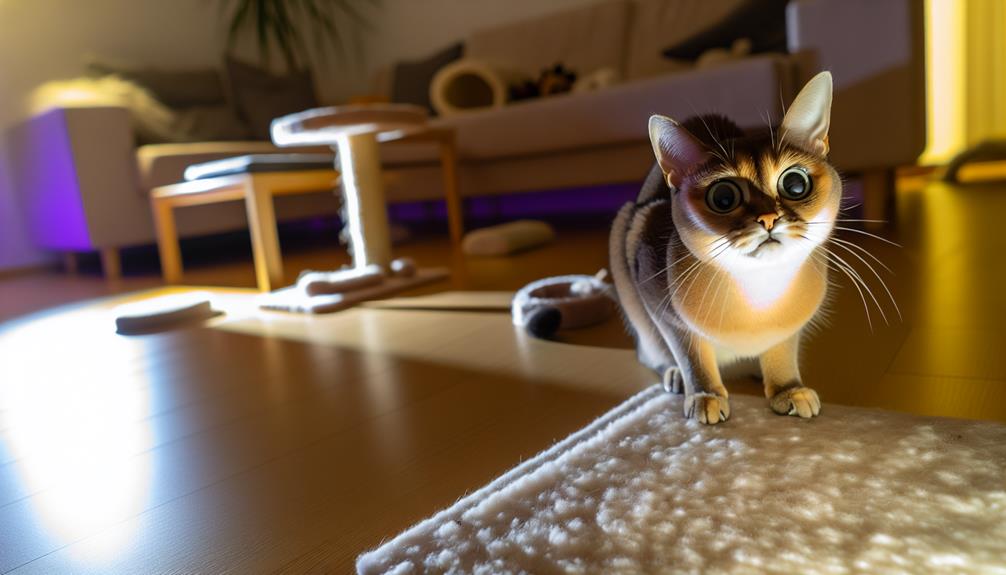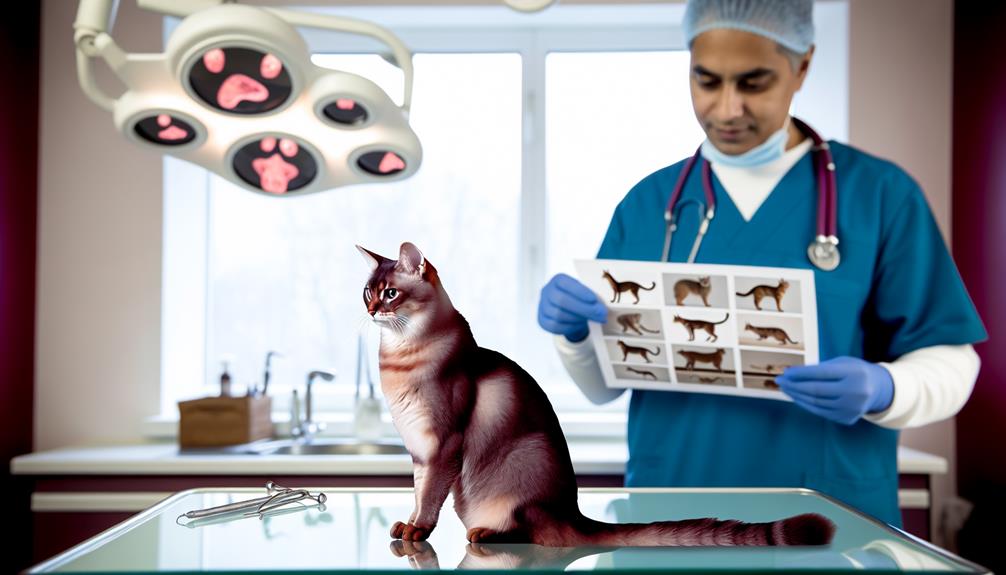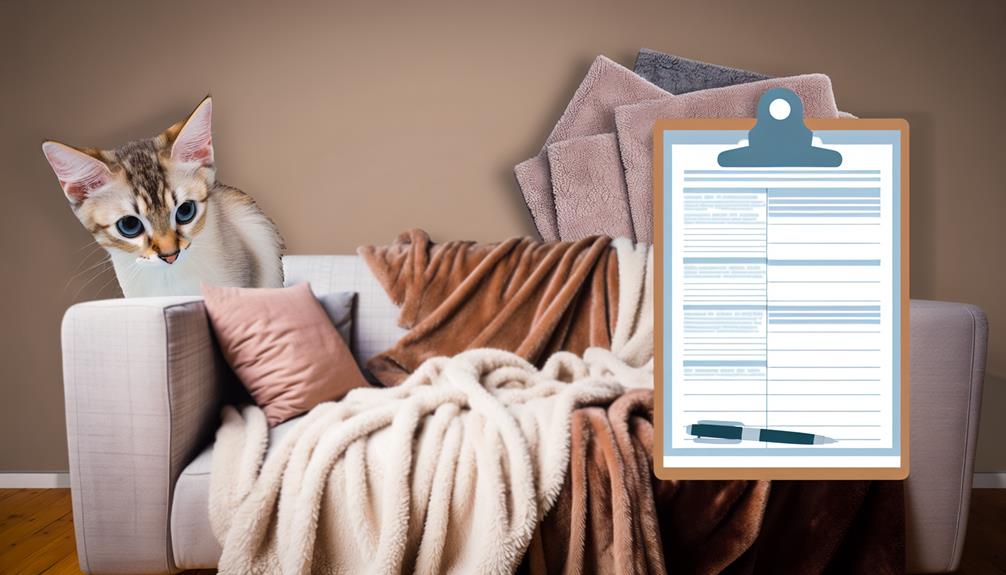Did you know that a female cat, or queen, can enter her estrous cycle every 2-3 weeks? Unlike humans, cats don't have periods in the traditional sense but experience phases of heat, marked by specific behavioral and physical changes. These cycles, designed to prepare them for mating, can bring about noticeable shifts in your cat's demeanor and habits. So, what exactly happens during this time, and how should you manage it? Understanding the intricacies of your cat's reproductive cycle can make a significant difference in her care and well-being. Let's explore what you need to know.
Understanding Feline Reproduction
Understanding feline reproduction is fundamental for any cat owner or breeder. Grasping the basics of feline anatomy and hormonal fluctuations can help you make informed decisions about breeding, health care, and managing your cat's reproductive cycles.
Firstly, let's consider feline anatomy. Female cats, or queens, possess a bicornuate uterus, meaning it has two horns that extend into the abdominal cavity. This structure is essential for accommodating multiple fetuses during pregnancy. The ovaries, located near the kidneys, play a significant role in reproduction by producing ova (eggs) and secreting hormones like estrogen and progesterone.
Hormonal fluctuations drive the reproductive cycle of a cat. Estrogen is the primary hormone responsible for initiating estrus, the period when a queen is sexually receptive. This hormone is produced by follicles within the ovaries. As these follicles mature, estrogen levels surge, preparing the queen's body for potential mating and pregnancy. Following mating and ovulation, progesterone takes over to support pregnancy if fertilization occurs.
Understanding these hormonal changes is crucial for recognizing when your cat is in heat and determining the best time for breeding. Additionally, it helps in identifying any abnormalities or health issues that may arise. For instance, persistent hormonal imbalances could indicate underlying conditions such as ovarian cysts or endocrine disorders, necessitating veterinary intervention.
The Estrous Cycle Explained
The estrous cycle in cats, commonly referred to as the heat cycle, is a complex interplay of hormonal changes that regulate reproductive readiness. Unlike menstrual cycles in humans, the feline estrous cycle involves a series of distinct phases that guarantee ideal conditions for mating and fertilization. Understanding these estrous phases can help you better manage and care for your cat's reproductive health.
The cycle consists of four primary phases: proestrus, estrus, metestrus (or diestrus), and anestrus. During proestrus, hormonal changes, particularly an increase in estrogen, prepare the cat's body for potential mating. This phase typically lasts one to two days, and while you might not observe overt behavioral changes, the cat's body is undergoing significant internal adjustments.
Next is the estrus phase, commonly known as "heat." This period, lasting about 4-10 days, is when the cat is most receptive to mating. The surge in estrogen levels triggers behaviors aimed at attracting mates. If mating occurs, ovulation is induced with the release of LH (luteinizing hormone), setting the stage for potential pregnancy.
Following estrus, the cat enters the metestrus phase. If the cat has mated, this phase involves the secretion of progesterone, maintaining the uterine environment for potential embryos. If mating didn't occur, hormonal levels gradually decline.
Finally, anestrus marks a period of sexual inactivity, typically during the shorter daylight hours of fall and winter. During this phase, the reproductive system rests and prepares for the next cycle.
Gaining insight into these hormonal changes and estrous phases will empower you to provide ideal care for your feline companion, guaranteeing her reproductive health and overall well-being.
Signs Your Cat Is in Heat

When your cat is in heat, you'll observe distinct behavioral changes such as increased affectionate actions and restlessness. Expect heightened vocalization patterns, often characterized by loud and persistent calling. Additionally, physical symptoms like excessive grooming and a noticeable change in posture, such as assuming a mating position, are common indicators.
Behavioral Changes Observed
Many cat owners notice distinct behavioral changes when their feline is in heat. These changes are driven by hormonal fluctuations and can vary widely among cats. Mood swings are common, with your cat oscillating between affectionate and irritable states. You might observe an increase in territorial behaviors, such as marking with urine or rubbing against furniture more frequently. Affection levels also change; some cats become overly clingy, seeking constant attention, while others may appear aloof.
Cats in heat often exhibit playfulness changes. They might become more energetic and playful, or conversely, lose interest in toys and activities they previously enjoyed. Grooming habits can intensify, with your cat spending more time licking and cleaning herself. This could be an attempt to mask her scent from potential mates. Sleep patterns also fluctuate; your cat might sleep less, staying awake and active during night hours.
| Behavior | Description | Example |
|---|---|---|
| Mood Swings | Oscillating between affectionate and irritable | Seeks attention, then hides |
| Territorial Behaviors | Increased marking and rubbing | Urine marking, face rubbing |
| Affection Levels | Clinginess or aloofness | Constantly seeking petting |
| Playfulness Changes | Increased or decreased playfulness | More active or less interested |
Understanding these behavioral changes can help you better care for your cat during her heat cycle.
Increased Vocalization Patterns
Observing behavioral changes in your cat is only part of the picture when she's in heat; increased vocalization patterns are another significant indicator. During estrus, your cat's vocalization types will likely change and become more frequent. The predominant vocalization is a persistent yowling or meowing, which serves as a communication signal to potential mates. This vocalization is typically louder and more intense than usual, often resembling a cry of distress but is, in reality, a mating call.
The increased vocalization can be attributed to elevated hormone levels, particularly estrogen, which directly affects your cat's behavior. This phenomenon is well-documented in feline reproductive cycles. Studies have shown that the vocalization patterns during estrus serve a dual purpose: they attract male cats while simultaneously alerting you, the owner, to her reproductive state.
Understanding these communication signals is essential for effective cat care. Not only do they inform you of her needs, but they also help you discern between normal estrus behavior and potential health concerns. If your cat's vocalizations seem excessive or are accompanied by other unusual behaviors, consult a veterinarian to rule out any underlying medical issues.
Physical Symptoms Noted
During estrus, you'll notice several physical symptoms that indicate your cat is in heat. These signs are primarily due to hormonal fluctuations that prepare the female for potential mating. One of the most evident physical changes is the swelling of the vulva, although it might be subtle compared to other species. Additionally, you'll observe increased grooming of the genital area, as your cat tries to manage the discomfort associated with these hormonal shifts.
Here are three key physical symptoms to watch for:
- Elevated Restlessness: Your cat may exhibit increased pacing or an inability to settle down, reflecting her heightened state of alertness and readiness to mate.
- Frequent Urination: Due to hormonal fluctuations, your cat may urinate more often, sometimes even spraying to mark territory, which serves as a signal to male cats.
- Postural Changes: A common sign is the lordosis posture, where your cat will arch her back, elevate her rear, and tread with her hind legs. This posture is a clear indication of her receptivity to mating.
Recognizing these physical changes can help you better understand your cat's reproductive cycle, enabling more effective care and management during her heat phases.
Managing Your Cat's Heat
When your cat enters estrus, commonly known as heat, it can be a challenging period for both the feline and the owner. The heat cycle is marked by significant hormonal changes, leading to noticeable shifts in cat behavior. During the breeding season, female cats become vocal, restlessly seeking a mate and displaying signs of mating readiness. These behaviors are driven by feline instincts vital for reproductive health.
Managing your cat's heat requires a thorough understanding of these hormonal changes and subsequent behaviors. Stress management is essential as your cat may exhibit increased agitation and vocalization. Providing a calm environment can help mitigate some of these stressors. Utilize environmental factors to your advantage; for instance, maintain a consistent routine and create quiet spaces where your cat can retreat.
It's important to monitor your cat's reproductive health during this time. Making sure she is well-hydrated and has access to a nutritious diet is vital. Pay attention to any signs of distress or unusual behaviors that may indicate underlying health issues.
To help manage mating readiness, distraction techniques can be effective. Engage your cat in interactive play or provide stimulating toys to divert her attention from mating behaviors. Additionally, consider using pheromone diffusers designed to reduce stress and promote relaxation.
In terms of cat care, regular grooming can provide comfort and reduce stress. A well-groomed coat can also prevent matting, which might become an issue during periods of heightened activity. Finally, keep your home secure to prevent any accidental escapes, as your cat's instinct to find a mate may lead her to explore beyond usual boundaries.
Understanding and managing your cat's heat cycle involves recognizing and addressing the complexities of cat behavior, hormonal changes, and overall reproductive health. By creating a supportive environment, you can promote the well-being of your feline companion during this challenging period.
Spaying and Health Benefits

Spaying, or ovariohysterectomy, is a surgical procedure that involves the removal of a female cat's ovaries and uterus, offering numerous health benefits and mitigating many challenges associated with the heat cycle. By opting to spay your cat, you're considerably reducing the risks of various health issues and behavioral problems that arise from not undergoing this procedure.
Spaying benefits include a marked reduction in the likelihood of mammary tumors, which are malignant in approximately 85% of feline cases. In addition, spaying prevents pyometra, a severe uterine infection that can be life-threatening if not treated promptly. The procedure also eliminates the possibility of ovarian and uterine cancers, guaranteeing a healthier life for your feline companion.
The health risks associated with not spaying your cat are considerable:
- Increased Cancer Risk: Unspayed cats are at a higher risk for mammary, ovarian, and uterine cancers.
- Pyometra: This condition, involving the accumulation of pus in the uterus, can be fatal and often requires emergency surgery.
- Behavioral Issues: Unspayed cats often exhibit distressing behaviors such as yowling, restlessness, and marking territory with urine during their heat cycles.
Additionally, spaying contributes to controlling the feline population, reducing the number of unwanted cats that end up in shelters. The procedure is typically performed when a cat is around six months old, although it can be done earlier or later based on veterinary advice. Always verify that the surgery is conducted by a qualified veterinarian to mitigate any potential complications.
Caring for a Breeding Cat
When caring for a breeding cat, you'll need to guarantee ideal nutrition and a balanced diet to support reproductive health. Effective management of the mating cycle requires monitoring estrous periods and timing copulation for successful breeding. Post-mating care involves close observation for signs of pregnancy and providing a stress-free environment.
Nutrition and Diet
Guaranteeing ideal nutrition for a breeding cat is vital for both her health and the health of her kittens. High-quality cat food formulated for breeding cats should be your primary choice, as it offers balanced protein sources and essential vitamin requirements. Tailoring her diet with nutritional supplements can further support her pregnancy and lactation periods. Remember, hydration needs are paramount; always provide fresh water to prevent dehydration.
Maintaining an ideal weight is essential, so closely monitor her weight management. Overfeeding can lead to complications, while underfeeding might result in malnutrition. Establishing consistent feeding schedules helps regulate her metabolism and guarantees she receives adequate nutrients throughout the day.
Be mindful of dietary restrictions; avoid feeding her foods that can cause toxicity, such as onions or chocolate.
Here are three important aspects to focus on:
- Protein Sources: Incorporate high-quality animal proteins like chicken or fish.
- Hydration Needs: Guarantee constant access to fresh water and consider wet cat food for added moisture.
- Vitamin Requirements: Include essential vitamins such as A, D, and E to support overall health.
Carefully managing these nutritional factors will promote a healthy pregnancy and robust kitten development.
Mating Cycle Management
Managing the mating cycle of a breeding cat requires precise timing and meticulous observation. You'll need to understand the cat's heat cycle, which typically occurs every two to three weeks during the breeding season. This cycle, also known as estrus, lasts about 4-10 days. It's essential to monitor for signs such as increased vocalization, restlessness, and a raised tail.
Effective breeding practices dictate that you pair the female with a compatible male during the peak of her estrus for ideal conception rates. Timing is critical, as the window for successful mating is relatively short. Confirm both cats are healthy and have undergone necessary health screenings to prevent the transmission of genetic disorders and diseases.
Keep detailed records of each cat's heat cycle, mating dates, and any observed behavioral changes. This data is invaluable for planning future breeding sessions and managing the overall health and wellbeing of your breeding cats. Additionally, providing a stress-free environment can enhance the chances of successful mating. By adhering to these guidelines, you'll facilitate a more predictable and manageable breeding process, safeguarding the wellbeing of your feline companions.
Post-Mating Care
Post-mating care is vital for guaranteeing the health and wellbeing of a breeding cat. After mating, you should observe your cat's post mating behavior closely to detect any signs of distress or infection. It's essential to provide a calm and comfortable environment to reduce stress, which can negatively impact a potential feline pregnancy.
Key Post-Mating Care Steps:
- Monitor Health: Check for any abnormal discharge, lethargy, or changes in appetite. These could indicate infections or complications requiring veterinary attention.
- Nutritional Support: Make sure your cat receives a balanced diet rich in essential nutrients. Pregnant cats have increased caloric needs, so consider specially formulated feline pregnancy food to support her health and the development of her kittens.
- Veterinary Visits: Schedule a veterinary check-up within the first few weeks post-mating to confirm pregnancy and assess overall health. Regular follow-ups can help identify any issues early, making certain both the mother and kittens remain healthy throughout the gestation period.
Conclusion
Understanding your cat's estrous cycle is key to managing her reproductive health. Think of it as a biological clock that's always ticking, indicating when she's ready to mate. Recognizing signs of heat and considering spaying can prevent unwanted litters and health issues. By providing informed care, you'll guarantee she leads a healthier, happier life. Remember, just like a finely tuned watch, your cat's reproductive system requires attention and precision for ideal well-being.
